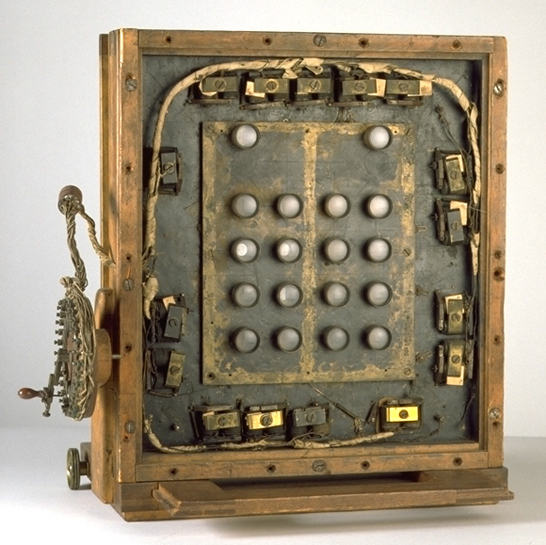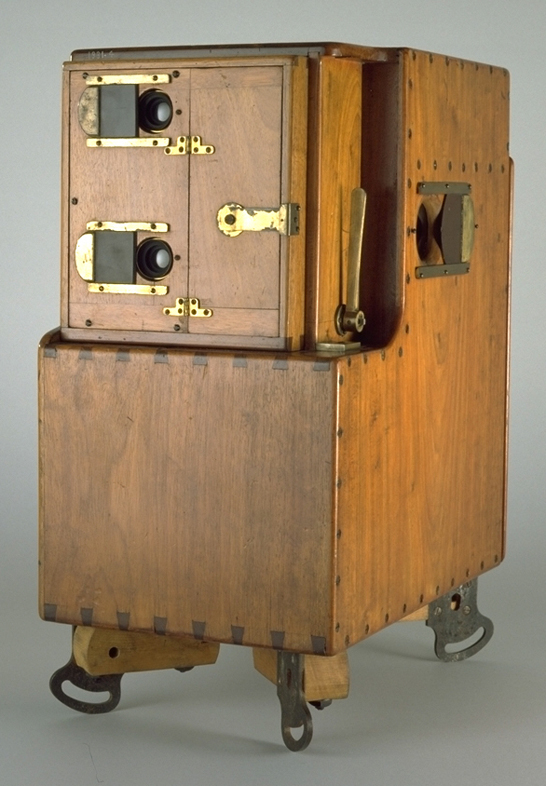One of the great mysteries of cinema history didn’t take place on the big screen, but—somewhat sensationally—occurred off-camera at the very beginning of the story of the moving image.
The tale of Louis Le Prince, the man regarded as the father of cinematography, ended in rather peculiar circumstances which have yet to be resolved. But for movie lovers everywhere, it’s his achievements in the last few years of his life which have granted him a place in the history books.
While Thomas Edison and the Lumière brothers dominated the headlines for inventing the equipment which made the moving image possible, Louis Le Prince preceded them by a number of years with a working model which captured motion outside his home in Roundhay, Leeds.
However, his achievements were not widely recognised—because shortly before a scheduled public performance of his technology, Le Prince went missing with no clues as to his whereabouts.
Many people have since speculated on his fate (with theories ranging from suicide to murder by rival cinematographers), but the one undisputed fact is that Le Prince was the first past the post with his pioneering work in the medium which would ultimately become film.
Who was Louis Le Prince?
Louis Le Prince was born in Metz, France in 1841 and had the fortune during his youth of regularly visiting a studio belonging to a friend of his father—the photographic inventor Jacques Daguerre.
After studying chemistry and physics at university, Le Prince moved to England at the invitation of John Whitley, before establishing the Leeds Technical School of Art where he specialised in tinting and firing of photographic images.

During the 1880s, Le Prince became fascinated with the early cinematic technologies which were then being developed. In 1886 he created a 16-lens camera and applied for an American patent on 2 November of the same year, receiving this at the beginning of 1888; on 16 November 1888, he received a British patent for his invention.
The Le Prince Single-lens Cine Camera, currently on display in our Animation Gallery, is believed to be the equipment used to film the famous Roundhay Garden and Leeds Bridge scenes. It proved to be one of the most groundbreaking inventions of early cinema.

While the contraption, which utilises paper-backed stripping film, may appear primitive by today’s standards, evidence that the equipment was successful in projecting moving images means that Louis Le Prince’s movies pre-date those of Edison and the Lumières by over half a decade.
In a cruel twist of fate, however, his disappearance meant that the world’s first movie maker never got the chance to accept the plaudits that came with such an achievement during his lifetime. He has since been posthumously rewarded his rightful status as the ‘Father of Cinematography’.
The first successful moving images in the world were recorded in Yorkshire, and it’s fitting that the equipment used to create them now lives here in Bradford, the world’s first UNESCO City of Film.
It is so incredibly sad when the first person to create something amazing does not get credit! Thanks.
WOW IAM 53 YRS OLD AND I HAVE JUST BECOME AWARE OF LE PRINCE ? SURELY MORE SHOULD BE DONE TO MAKE FUTURE GENERATIONS AWARE OF “LOUIS LE PRINCE ” ???
I am 71 and just became aware of Mr. LePrince. You’re right. Our history books need a major overhaul on so many subjects, like this one.
I am currently reading about his history right now in US history as a junior. This is something I found completely on my own and it is so fascinating!
Keep up the independent study; the more you learn, the more you’ll want to learn. Fyi, when you Americans say things like ‘sophmore’ or ‘junior’ etc, only you know what you’re talking about. Most of us on this world-wide web don’t.
it is but nature is nature it remains unchanged
This is why we are making a feature length documentary THE FIRST FILM to rectify this fact !
You weren’t the first with that; back in the previous century, Christopher Rawlence made a film (and subsequent book) in 1989 about Le Prince titled THE MISSING REEL. It was made for the UK’s Channel Four and while not widely distributed, I would have thought you’d have come across it in your researches.
Hey and Is by now the film ready? Now we can take the chance to let everyone know about le Prince real film creator
I am 21.. it’s amazing how LE PRINCE inverted this and we benefit it.
Intriguing, thanks – and yay for another Yorkshire first!
Huh, very interesting how Le Prince would just leave before he got any credit… Hmmm…
Watch Unsolved on Youtube. They featured this mystery.
Theories abound. As I remember from The Last Reel, Le Prince got on a train and disappeared on his way to the demonstration which might have made his fortune.
William Friese-Greene was also working at this time. He made his own celluloid film which he used with his second camera in January 1889, shooting in presumed stereo vision with a double lens, at twelve frames per second. It did not project well. By June he had achieved persistence of vision at sixteen frames per second with his third single lens camera, using cut down 72mm Eastman Brownie preloaded box camera film, [thus 35mm]. By 1890 his films were being shown in London.
I like to think that if Le Prince came through London on his way home, he encountered Friese-Greene’s work and realised that he had lost a march and that his machine was obsolete. Perhaps he could not face a perceived disgrace and decided to get off the train at some little country station and retire to a small market town where he was not known. Who knows? Maybe one day his last camera will be found in the attic of an old dwelling, and then we may know. Until then….
According to an article I read, Thomas Eddison had him killed. He wrote it in one of his journals that was found in the New York library.
Here’s the article I read
https://www.sciencedirect.com/science/article/pii/S1369702108701603
wow to think Louis may have been killed just so Eddison could be known as the first person to invent moving pictures
Excellent information, thank you. I am reading Louis’ life story and have not come across anything where Edison admitted to having him killed! A whole new image of Thomas Edison for sure.
This interesting article talks about a recent discovery in one of Edison’s journals talking about Le Prince.
https://www.sciencedirect.com/science/article/pii/S1369702108701603
Amazing info! Thanks for the link. If Edison truly had a hand in the murder of Le Prince, this changes his entire legacy.
He had found a small entry dated September 20, 1890 by Edison’s own hand which read, “Eric called me today from Dijon. It has been done. Prince is no more….”
Eric “called”? Via trans-Atlantic telephone in 1890? Was Edison in France?
Edison was in Paris a year earlier, returning to NJ in Oct ’89. Seems quite unlikely to claim he was receiving a call from Dijon, a year later.
Yes, very odd given the first telephone call was only made in 1876. The word “call” in the Edison context sounds too modern as well.
Also found the following on Arabella Flynn’s website:
“There is an article that claims a grad student found a journal of Edison’s that contains what amounts to an admission that he had Le Prince killed, but I doubt the ever-loving **** out of this thing: I can find no trace of “Alexis Bedford” (the grad student, noted by pronoun as male, supposedly studying chemistry and photography), “Charlene Edmonds” (the librarian who supposedly verified that the journal he found was part of the historical collection), or “Robert E Myre” (the historian that Bedford supposedly took the journal to for verification that it was Edison’s). The article alleges that Bedford found the evidence in the “New York library”, which is not a thing that exists — the New York public library system is the largest state library system in the US, and any real article would have noted the branch — and refers to the school where Bedford was studying as the “University of New York”, which isn’t a thing either. It appears under the “Opinions” banner, so presumably it got no fact-checking.”
honestly i find it quite strange that he made a ’16’ lens camera,he recived a patten on it on the ’16’ of november and he went missing on the ’16’ of september to be honest i fell like it was suicide cause obviously the number 16 has some importance to him
Lol
is this exhibition still here?
this is all just really confusing. I’m doing an assignment for school about this mystery of a dude, I don’t know what the heck is happening.
Regarding the article referenced above from “science direct.com” — Edison could not have received a “call” from Dijon. Transatlantic telephone service didn’t become a practical reality until the 1920s. 19th century people referred to personal visits as “calls” but that is not what is implied. Additionally, Edison is quoted as having written, “Murder is not my thing.” No one wrote or talked like that in the 19th century! Edison also supposedly reminded himself that he was an inventor of inventions. The real Edison would not have bothered to tell himself that. Also, the last sentence is awkward with him saying to that his plans for “moving pictures” can now “move forward.” The article, and it’s supposed researchers and experts are not cited. The entire article is totally fabricated! Don’t believe it!
Gives a lot of information just wish there was more…
I heard a radio 4 program about this, late one night but couldn’t find it subsequently. Thought I had dreamt it!
Le Prince’s wife always believed it was Edison.
Also was she in the garden scene in Yorkshire?
I wonder what happened to him and where his body is?????🤔
Credit must be given to the Local Authority who recognised Louis by having a Street named after him
You are all looking in the wrong place. The only information about Le Prince’s final day, traveling to Paris via train, etc. comes from his brother. Le Prince visited his brother hoping to clarify their mother’s will. He was 1000£ in debt over the design and building of his camera, shooting the film, etc. At the time only filmmakers knew the worth of motion picture cameras and how important this would be in the future. The brother may have seen Le Prince’s debt and his luggage as useless. He could have killed Le Prince, taken the money, and made up the story of his training to Paris.
I’ve just read The Disappearer by C.D.Rose from his collection, Walter Benjamin Stares At The Sea, and it chronicles Le Prince’s triumphs and disappearance. Initially I thought the story was a compelling piece of fiction so I was delighted to discover that Le Prince was indeed the father of cinematography and that his camera is now housed in Bradford. My money’s on the brother knocking him off.